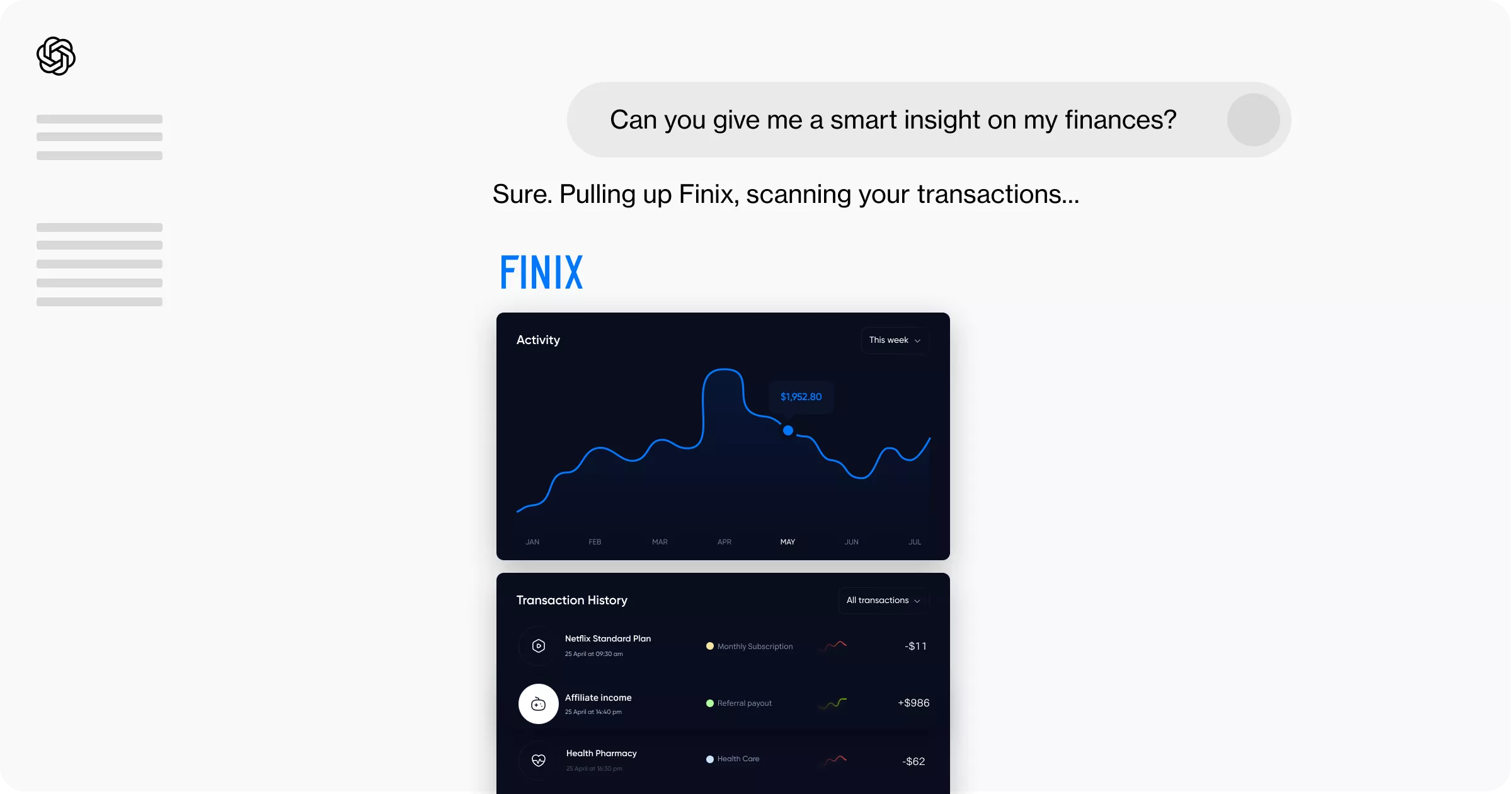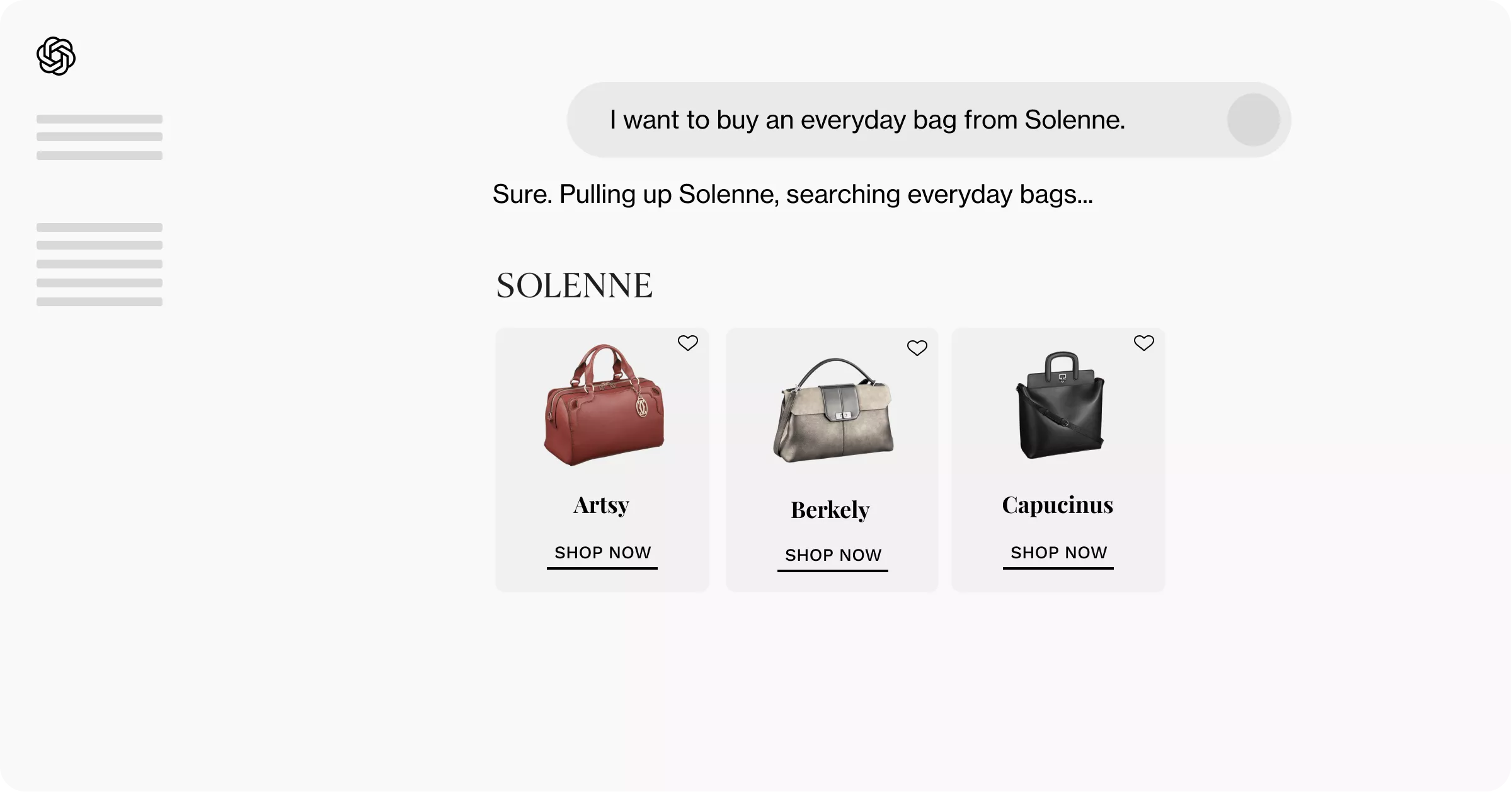OpenAI’s new Apps SDK unlocks a powerful new frontier where apps live inside ChatGPT – interactive, real-time, and seamlessly part of natural conversation. This shift is going to redefine how customers discover, interact with, and purchase digital products. And it’s a big deal.
There are moments in tech when everything changes: the rise of the web, the move to the cloud, the boom of app stores. We believe we’re witnessing the next one: apps inside ChatGPT.
What are the apps inside ChatGPT, and how do they work?
OpenAI’s new Apps SDK allows developers to build native apps that live inside the ChatGPT interface, enabling users to transact, explore, and interact through natural language.
Instead of asking users to visit your site, download your app, or fill out a form, you’ll be able to meet them where they already are: inside ChatGPT, right in the flow of conversation.
WELCOME TO THE ERA OF CHATGPT APPS.
Whether users are booking a trip, checking their finances, or buying a product, the entire customer journey happens in one interface: fast, intuitive, and frictionless.
For users, it means fewer redirects and smoother interactions. For brands, it opens up a new channel, a new revenue stream, and a more direct way to turn interest into action.
At Infinum, we’ve been building mobile and web apps for 20 years. We know how to work with app stores, backend platforms, complex UX, and intelligent, agentic automation.
ChatGPT Apps feel like a natural next step, and we are ready to help you claim a place in the new AI-native web.
Why GPT Apps are a turning point for digital experiences
ChatGPT is no longer just a place to ask questions.
With over 800 million weekly ChatGPT users, it’s quickly becoming a connective layer of the internet, bringing together natural information, easily accessible information, and now services into one unified flow.
Success now means being genuinely useful at the exact moment of need, not the loudest voice in the room.
People don’t search for answers anymore – they expect to ask and get them instantly. With 74% of consumers embracing chat and voice assistants, brands have a once-in-a-generation opportunity to capture first-mover advantage, define the new standard of customer experience, and be truly innovative in their vertical.
KASPER KUIJPERS, FOUNDER & CTO OF YOUR MAJESTY, PART OF INFINUM
And while it was only a matter of time before ChatGPT moved beyond search and became a platform for doing, this isn’t happening in isolation.
Microsoft Copilot, Google Gemini, and Meta’s AI efforts are all moving toward embedding services into conversational AI. But OpenAI’s ChatGPT is leading the way with native app capabilities.
What GPT Apps can do for your business
1
Get discovered at the right moment
ChatGPT actively recommends apps based on users’ requests. Your brand can appear in conversations that match your offer, opening an organic path to discovery.
2
Reduce friction to boost conversions
No downloads, no redirects, just a question and an answer. Embedding your product or service directly in the conversation shortens the conversion funnel.
3
Build a high-intent revenue stream
Unlike traditional ads that try to create interest, GPT Apps connect you with people who already have it. You’re meeting users right when they’re expressing a need, turning intent into action.
4
Shape the market as an early mover
Like in the early days of the App Store, early adopters will shape expectations, gain visibility, and build loyalty, all while unlocking opportunities for new kinds of applications and businesses to emerge.
5
Learn from real interactions
Every conversation tells you something: what users want, where they drop off, and how you can improve their experience.
What you can build inside ChatGPT Apps
ChatGPT Apps combine the best of conversation and interactivity, creating experiences that feel both natural and capable. Here’s what you can build:
Conversational commerce experiences
Let users discover, compare, and purchase products directly in chat. Offer personalized recommendations, real-time inventory checks, and seamless checkout flows. For bonus points, let users delegate actions like “If this laptop’s price drops below X, buy it.” The agent can track prices and automatically execute approved actions.
Personalized recommendations, booking, and scheduling
Combine AI with your business logic to provide custom suggestions: products, learning paths, travel plans, or wellness routines tailored to each user’s needs. Building off of recommendations, allow users to book appointments, trips, rentals, or restaurant tables through simple conversation. With calendar integrations and smart prompts, booking becomes effortless.
Data analysis & visualization
Let users analyze personal or business data: spending, health, traffic, engagement, and more, and get instant visualizations, comparisons, and insights.
Configuration & support
Turn FAQs, troubleshooting, and account management into guided conversational flows. Users can set up services, customize products, solve issues, update details, or access information without switching channels or contacting support.
Real-time transactions
Let users complete actions like money transfers, document signing, or file uploads directly in ChatGPT conversations.
Microlearning & training
Deliver short, interactive lessons for education, compliance, or professional development, perfect for learning in context or on the go.


Which industries can benefit from Apps inside ChatGPT?
While retail and ecommerce are the obvious front-runners, because of the direct path from browsing to purchase, any business offering a product or service can benefit from GPT-native experiences.
Travel services can handle accommodation, car rentals, ticketing, and dining booking, confirmations, and itinerary changes through natural queries. In finance and insurance, users can analyze spending, receive optimization advice, or complete policy onboarding, all without forms or separate logins.
In healthcare, apps can track metrics from wearables and suggest personalized health actions or recommend lifestyle adjustments. For education, GPT-native apps can analyse lessons and learning materials, generate study plans, and adapt based on progress. Even real estate, legal, and public services can use this channel to offer instant document reviews, local insights, or access to experts. And with the Internet of Things, GPT-native experiences can bridge voice, sensors, and automation, letting users control, monitor, and optimize connected devices just by asking.
The unifying theme? If your customers can ask for it, we can build an experience for it.
How to prepare for ChatGPT App integration
ChatGPT App development takes both strategic readiness and technical execution. We recommend focusing on speed, ROI, and user experience.
STRATEGIC READINESS
01
Identify conversational moments
Ask: where would chat feel more natural than forms or menus? Review support tickets, drop-off points, and key product flows. Look for places where a simple prompt can replace a multi-step process. Need help mapping this? We can guide discovery and user research.
.
02
Audit your data
Map out your data sources, formats, and ownership. Check for accuracy, duplication, and sensitive fields that shouldn’t be exposed. Classifying your data early prevents compliance risks and ensures AI works with clean, reliable inputs later on.
.
03
Design for conversation
GPT Apps aren’t websites in a chat box, they’re apps that feel like dialogue. That means designing flows that are short, contextual, and responsive. Focus on natural prompts, clear responses, and interaction patterns that match how people actually talk while staying true to your brand voice.
TECHNICAL EXECUTION
04
Connect your systems
Your backend probably doesn’t need an overhaul – just a smart integration layer that exposes it through the Model Context Protocol. By implementing an MCP server around your API, you’ve already done most of the work to join the GPT Apps ecosystem. Then, add secure session handling and real-time sync to enable dynamic content.
.
05
Build and test with the Apps SDK
Set up the Apps SDK, implement OpenAI’s Model Context Protocol, and build a responsive front end. Validate with real user flows, track where users succeed or stall, and iterate quickly to ensure product-market fit.
.
06
Prepare for marketplace launch
A compelling app isn’t just functional, it’s discoverable. Once your app is ready, we can help refine branding, connect analytics, and ensure conversion optimization post-launch.
Technical foundation for GPT Apps
To build a production-ready GPT App, your stack should include:
- Well-documented APIs for core business functions (e.g., pricing, account access, bookings)
- Secure authentication flows to manage sessions within the GPT context
- Lightweight frontend assets (HTML/CSS/JS) that can be rendered inline or full-screen inside ChatGPT
- Structured data sources like product catalogs or user history for personalized responses
- Integration via Model Context Protocol (MCP) so ChatGPT understands and responds in sync with your app’s state
- Optional: analytics hooks to monitor usage, performance, and conversion in real time
We help you scope, prioritize, and build what’s needed, starting with use cases that deliver clear user and business value.
Why act now?
GPT Apps are in early rollout, which means the market is open, but it won’t be for long. Just like early app store adopters or companies that invested early in mobile, the ones who explore ChatGPT apps first will enjoy:
Greater visibility as one of the few apps in a category
More room to define interaction patterns and user expectations
Better data, sooner, giving you a head start on optimization
By the time this ecosystem matures, brands that moved early will have more traction, more insights, and a stronger position.
Should you build in-house or outsource?
If you already have strong in-house teams across AI, UX, and platform engineering, you can probably build internally.
But if speed, quality, and confidence matter, partnering with a team like Infinum can get you further, faster.
For over two decades, we have been building award-winning digital products that succeed in competitive ecosystems, including the Apple App Store, Google Play, and enterprise marketplaces.
We know what it takes to build for evolving platforms.
Our experience with marketplaces, app standards, and the OpenAI Apps SDK means we can turn early ideas into launch-ready products with clarity and precision.
What we offer:
- Discovery workshops to align goals and identify opportunities
- Rapid prototyping and MVP delivery to test the market quickly
- Full-stack engineering for production-ready GPT Apps
- Post-launch support, analytics, and iteration
Your move: build where 800M users already are
ChatGPT-native apps represent a shift in how users find and use digital products. Infinum is here to help you be part of that change, from strategy to shipping.
Let’s turn your service into a ChatGPT-native app and get you in front of 800 million users, faster.










